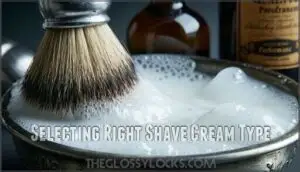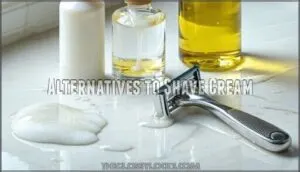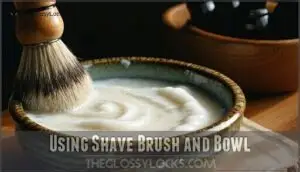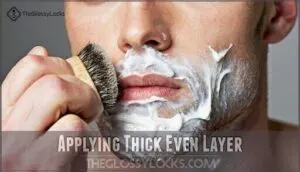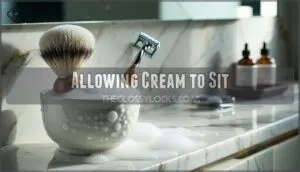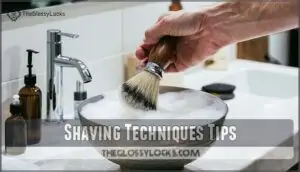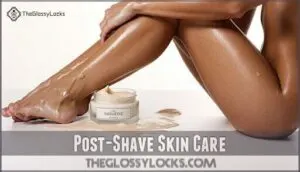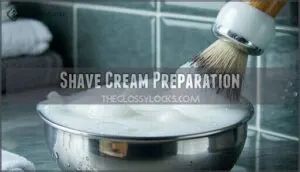This site is supported by our readers. We may earn a commission, at no cost to you, if you purchase through links.

Wet your face for two minutes, then apply a gentle cleanser to remove dirt and oil.
Use a quality shaving brush to work cream into a thick, rich lather. Don’t rush this step – think of it as laying the foundation for your house.
Apply the cream in circular motions, creating an even layer that stands up like meringue. Let it sit for a minute to soften your whiskers.
This preparation makes all the difference between a smooth shave and razor burn. The real magic happens when you master the perfect lather technique.
Table Of Contents
- Key Takeaways
- Pre Shave Skin Prep
- Choosing Shave Cream
- Applying Shave Cream
- Shaving Techniques Tips
- Post Shave Skin Care
- Shave Cream Preparation
- Frequently Asked Questions (FAQs)
- How do you use a shave cream?
- How do you use a shave cream if you have sensitive skin?
- How do I prepare my skin for a smooth shave?
- Should you make a homemade shave cream?
- Should you use shaving cream before Shave?
- How do I prepare my face before shaving?
- How do you shave your neck without getting razor bumps?
- Can you exfoliate and shave on the same day?
- How do you shave properly?
- What to do before applying shaving cream?
- Conclusion
Key Takeaways
- Prep your skin properly – You’ll need to wash your face with warm water and a gentle cleanser, then soften your beard hair with a warm towel for 2-3 minutes before applying any shaving cream.
- Create the perfect lather – Don’t rush this step; use a quality shaving brush to work the cream into a thick, rich lather that stands up like meringue and provides complete protection.
- Apply cream correctly – You’ll want to use an almond-sized amount and spread it in a thick, even layer across all areas so that you can’t see the skin through the cream.
- Let it sit and work – Allow your shaving cream to sit for 1-2 minutes before shaving to soften whiskers and maximize protection, then use short strokes with minimal pressure, following your hair’s natural grain.
Pre Shave Skin Prep
You can’t build a solid house on a shaky foundation, and the same goes for shaving – proper skin prep sets you up for a smooth, irritation-free shave.
You can’t rush greatness – the best shaves start with patience and proper preparation.
Start by washing your face with warm water and a gentle cleanser, then soften your beard hair with a warm towel for two to three minutes before applying any shaving cream.
Soaking and Exfoliating Skin
Before diving into your shave, proper skin preparation sets the foundation for success.
Soak your face with warm water for five minutes to open pores and soften stubborn whiskers.
Exfoliate 2-3 times weekly using gentle circular motions to remove dead skin cells and prevent ingrown hairs.
A pre-shave oil can mitigate sensitive skin and this essential prep work transforms tough beard hair into manageable strands, making your razor glide effortlessly, resulting in a more comfortable shave with less irritation.
Using Warm Water and Towels
After your skin’s properly soaked, grab a warm towel for the next step in your shaving preparation.
Water temperature effects are real – hot water opens pores while warm towels provide gentle heat.
Apply the towel to your face for 2-3 minutes, focusing on beard areas.
This towel application method offers warm towel benefits by softening beard hair, making your upcoming shaving cream preparation more effective.
Cleaning and Hydrating Skin
After your warm towel treatment, proper skin cleansing becomes your next priority.
Use a gentle cleansing routine with hydrating cleansers to remove dirt and oils.
Warm water benefits include opening pores for deeper cleaning.
Maintain exfoliation frequency at 2-3 times weekly for ideal skin preparation.
Apply pre-shave oils afterward to create a protective barrier that enhances skin hydration before shaving preparation begins, ensuring a smooth process with proper skin cleansing.
Choosing Shave Cream
You’ll find dozens of shaving creams on store shelves, but picking the right one makes the difference between a smooth shave and razor burn.
The best cream protects your skin, creates a rich lather, and works with your specific skin type, whether you’re dealing with sensitive skin or coarse facial hair.
Selecting Right Shave Cream Type
When choosing your shaving cream, consider your skin type first.
Look for cream ingredients like aloe vera and glycerin if you have sensitive skin.
Scent preferences matter too—some find strong fragrances irritating.
Budget considerations shouldn’t sacrifice quality; a good shaving cream protects your skin.
Natural ingredients typically work better than synthetic alternatives for most skin types.
You should also consider how well the cream enhances razor performance.
Considering Sensitive Skin Needs
When sensitive skin acts up during shaving, you’ll want to reach for hypoallergenic creams packed with soothing ingredients like aloe vera and allantoin.
Skip shaving cream with harsh fragrances—fragrance-free products work best.
Look for alcohol-free aftershave options that won’t sting.
Gentle exfoliation before shaving helps, but avoid overdoing it.
Your skin will thank you.
Alternatives to Shave Cream
When you’re out of shaving cream, don’t panic.
Several household items can save your shave and deliver smooth results.
Here are proven shaving cream alternatives that work:
- Hair conditioner – Provides excellent lubrication and visibility without foaming
- Coconut oil – Melts on contact, offering natural antibacterial protection
- Body oil – Creates a slippery barrier for effortless razor gliding
- Aloe vera – Soothes skin while enabling smooth cuts.
These options can also help reduce skin irritation effectively.
Applying Shave Cream
Once you’ve chosen your shaving cream, the application technique determines whether you’ll get a smooth, comfortable shave or deal with nicks and irritation.
Apply the cream evenly across your skin, creating a thick barrier that protects and lubricates while allowing your razor to glide effortlessly, ensuring a smooth shave.
Using Shave Brush and Bowl
Natural bristle brushes need a warm water soak for best performance, while synthetic bristle brushes require just a quick wet.
Squeeze out excess water, then swirl your shaving brush on soap using circular motions for thirty seconds.
Build lather in your shaving bowl until you achieve that perfect light consistency that’ll transform your morning routine.
A proper shave bowl improves lather is essential for a perfect shave, and using it will help you achieve a light consistency.
Applying Thick Even Layer
Once you’ve created your shaving cream lather, applying a thick even layer becomes your next priority.
Cover all areas completely – you shouldn’t see skin through the cream. This ideal thickness provides protection and smooth gliding.
To further enhance the process, consider using a cream that reduces razor irritation.
Use application tools like brushes for even coverage, avoiding clogging your razor. Product alternatives work similarly, requiring the same thorough shaving cream application technique.
Allowing Cream to Sit
Patience pays off when you let your shaving cream lather sit for 1-2 minutes before picking up that razor.
This waiting period allows for enhanced protection through ideal hydration and hair softening.
Product absorption works its magic, creating reduced irritation during your shave.
Think of it as marinating your whiskers – proper shaving cream application timing transforms your entire experience, providing ideal hydration.
Shaving Techniques Tips
Once you’ve applied your shaving cream properly, your technique determines whether you’ll get a smooth shave or end up with nicks and irritation.
You’ll want to use short, controlled strokes while following your hair’s natural growth pattern.
Don’t forget to rinse your razor frequently to keep it working effectively.
Shaving With Grain and Against
When mastering your shaving technique, hair direction mapping becomes your secret weapon.
Shaving with the grain reduces irritation but offers moderate closeness, while going against provides superior results with higher discomfort risk.
This closeness vs. comfort trade-off requires technique customization based on your skin sensitivity.
Start with grain shaving benefits, then experiment with direction changes for ideal hair growth management and personalized shaving preparation.
Using Short Strokes and Minimal Pressure
In terms of achieving a smooth shave without irritation, your shaving technique makes all the difference.
Proper pressure control and stroke length prevent razor burn while protecting skin sensitivity.
Here are three essential tips for perfect shaving technique:
- Keep strokes short and deliberate – Use 1-2 inch movements following your hair’s natural grain
- Apply gentle pressure – Let the razor’s weight do the work, don’t press down
- Maintain consistent blade angle – Hold your razor at 30-45 degrees against your skin
To further enhance your shave, consider softening beard hair with a hot towel.
Rinsing Razor and Maintaining Visibility
Clean your razor blade every few strokes to prevent hair buildup and clogging.
Rinse under warm water, giving it a gentle shake to clear stubborn whiskers. This simple step maintains blade sharpness and keeps your shaving path visible.
When you can’t see through the cream anymore, it’s time for another rinse—your skin will thank you. This action is part of maintaining sharpness and ensuring a clean shave.
Post Shave Skin Care
Your shave doesn’t end when you put down the razor, and what you do next determines whether you’ll have smooth, comfortable skin or deal with irritation for hours.
Proper post-shave care protects your freshly shaved skin, prevents razor burn, and keeps you looking sharp until your next shave, which is crucial for maintaining smooth skin.
Rinsing and Drying Skin
After mastering proper shaving techniques, your next move involves thorough rinsing and gentle drying. Remove every trace of shaving cream rinse with lukewarm water, then switch to cold water for pore-closing benefits.
This skin preparation step sets you up for ideal post-shave care and healthier skin.
Essential rinsing and drying tips:
- Cold Water Benefits – Splash cold water on freshly shaved skin to close pores, reduce inflammation, and prevent bacteria from entering
- Microfiber Towels – Use clean microfiber towels instead of regular terry cloth to minimize friction and skin irritation during drying
- Patting Skin Dry – Gently pat your skin rather than rubbing vigorously to avoid aggravating sensitive, freshly shaved areas
- Air Drying – Allow skin to air dry for 30-60 seconds before applying products, giving your skin time to naturally settle
- Toner Application – Consider using an alcohol-free toner after rinsing to balance pH levels and prepare skin for moisturizing
Applying Moisturizer and Aftershave
Once you’ve patted your skin dry, apply an alcohol-free aftershave balm to soothe freshly shaved areas.
Follow with a lightweight moisturizer to lock in hydration – this step’s essential for healthy skin moisturization.
Many prefer to use products for sensitive skin to avoid irritation.
Consider using a toner to balance your skin’s pH and tighten pores.
For morning shaves, finish with sunscreen application since freshly shaved skin needs extra protection from UV damage.
Avoiding Irritation and Ingrown Hairs
Preventing razor burn and ingrown hairs becomes second nature with the right approach.
Your post-shave routine can make or break your skin’s health, especially when dealing with sensitive areas that demand extra attention.
- Exfoliation methods: Gently scrub 2-3 times weekly with a soft brush to prevent dead skin buildup
- Product ingredients: Choose alcohol-free aftershaves with soothing aloe or witch hazel for ingrown prevention
- Shaving frequency: Allow 24-48 hours between shaves to let skin recover completely
Shave Cream Preparation
Getting the right amount of shaving cream isn’t rocket science, but it’s the difference between a smooth shave and a razor-burned mess.
You’ll learn to measure cream properly, create a rich lather that protects your skin, and apply it like a pro while avoiding common mistakes that lead to irritation, which is key to a pro shave.
Measuring Right Amount of Cream
Most shavers typically use around 4 grams of shaving cream per session, which covers your entire beard area effectively.
Getting the right amount isn’t rocket science, but it’s the difference between smooth skin and razor-burned regret.
You’ll need just an almond-sized amount when using a brush, or measure cream quantity by squirting it across two fingers for direct application.
This prevents avoiding excess while ensuring proper lather consistency. Remember, less is often more with quality shaving cream, and using the right amount is crucial for a good shave, making quality shaving cream effective.
Creating Lather and Applying Cream
Mastering lather consistency transforms your shave from ordinary to extraordinary.
Load your shaving cream brush with product, then work it in circular motions within your shaving cream bowl.
Build a rich, creamy shaving lather that’s neither too thick nor watery.
A quality cream also softens the skin for a smoother shave.
Apply this perfect mixture using upward brush strokes, ensuring even application thickness across your entire shaving area for ideal protection.
Tips for Sensitive Skin and Ingrown Hairs
Sensitive skin requires extra care when choosing shaving cream for sensitive skin.
Select fragrance-free products to minimize skin irritation and razor bump prevention.
- Use gentle exfoliation before shaving to clear dead skin cells
- Apply thick, protective shaving cream layers for smoother glides
- Choose soothing aftershave balms without alcohol or harsh chemicals
- Treat ingrown hairs with specialized ingrown hair treatment products immediately
Frequently Asked Questions (FAQs)
How do you use a shave cream?
Like applying armor before battle, you’ll squeeze an almond-sized amount of shave cream into your palm.
Rub it smooth, then spread a thick, opaque layer over damp skin, ensuring complete coverage.
How do you use a shave cream if you have sensitive skin?
Choose shaving cream labeled "for sensitive skin" or "soothing."
Apply a thick, opaque layer to clean, warm-water-softened skin.
Let it sit 1-2 minutes before shaving with gentle strokes following hair growth direction.
How do I prepare my skin for a smooth shave?
Start with warm water to soften hair and open pores.
Cleanse your face, then exfoliate gently to remove dead skin cells.
Apply pre-shave oil for protection, ensuring your skin’s clean and ready for shaving cream.
Should you make a homemade shave cream?
You can make homemade shave cream, but store-bought options typically work better.
Commercial creams offer superior lubrication, protection, and consistency.
If you’re experimenting, try simple recipes with natural oils and moisturizing ingredients.
Should you use shaving cream before Shave?
Yes, you should definitely use shaving cream before shaving.
It creates a protective barrier, softens hair, lubricates skin, and reduces friction.
This prevents nicks, cuts, and irritation while ensuring a smoother, more comfortable shave.
How do I prepare my face before shaving?
Sharp razors reduce skin irritation by 70%, making prep essential.
Wash your face with warm water, then apply a hydrating cleanser.
Exfoliate gently, use a warm towel for two minutes, and finish with pre-shave oil.
How do you shave your neck without getting razor bumps?
Shave with the grain, not against it. Use light pressure and short strokes.
Stretch your skin taut while shaving. Rinse your razor frequently.
Apply a thick layer of shaving cream for protection.
Can you exfoliate and shave on the same day?
Like Rome wasn’t built in a day, your skincare routine needs timing.
You can exfoliate and shave together, but space them apart by several hours.
Exfoliate first, then shave later to avoid irritation and razor burn.
How do you shave properly?
Begin with warm water to soften hair and open pores.
Apply thick shaving cream, then use short strokes with the grain.
Rinse your razor frequently, stretch skin taut, and finish with cold water and moisturizer.
What to do before applying shaving cream?
Before applying shaving cream, cleanse your face with warm water and a gentle cleanser.
Exfoliate to remove dead skin cells, then soak the area with warm water for five minutes to soften hair and open pores.
Conclusion
Like getting your best Instagram shot requires the perfect lighting, mastering these shaving cream preparation tips requires patience and practice.
You’ve learned the fundamentals: proper skin prep, choosing quality cream, creating that perfect lather, and applying it correctly.
Remember, rushing through preparation leads to razor burn and disappointment.
Take your time with each step, especially building that rich, protective lather.
Your face will thank you with smoother shaves and healthier skin every single morning.
- https://my.clevelandclinic.org/health/articles/23089-collagen
- https://wetshavingproducts.com/blogs/articles/how-many-shaves-do-you-really-get-per-can-of-shaving-gel?srsltid=AfmBOoq7depTdh2ABuM-GHGIE_kMwDQ7bfgkqn6SDQEcbSv4_uiV2FH_
- https://www.badgerandblade.com/forum/threads/how-much-cream-do-you-use.557066/
- https://shavenation.com/products/mini-scoop-spoon-for-shaving-soaps-and-creams
- https://www.reddit.com/r/wicked_edge/comments/2ycik9/how_much_cream_do_you_use/

